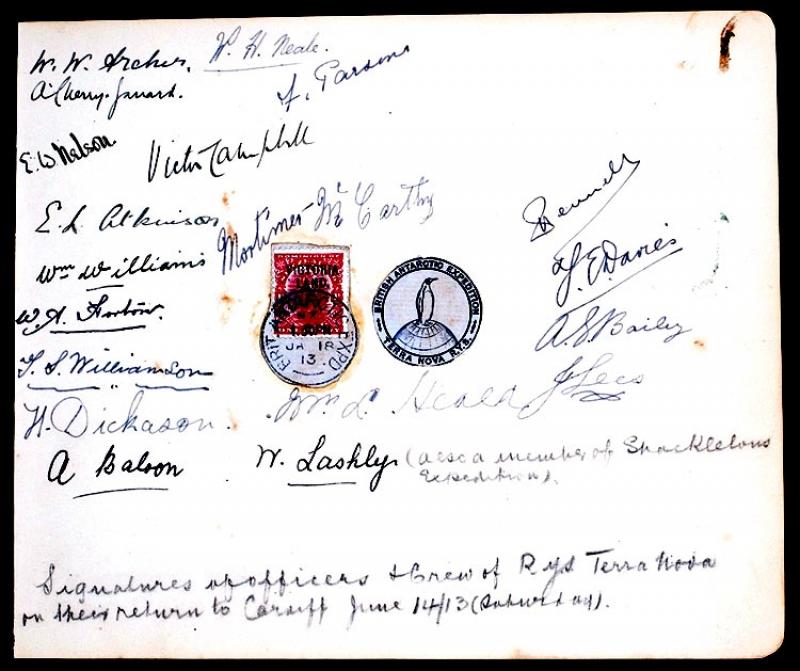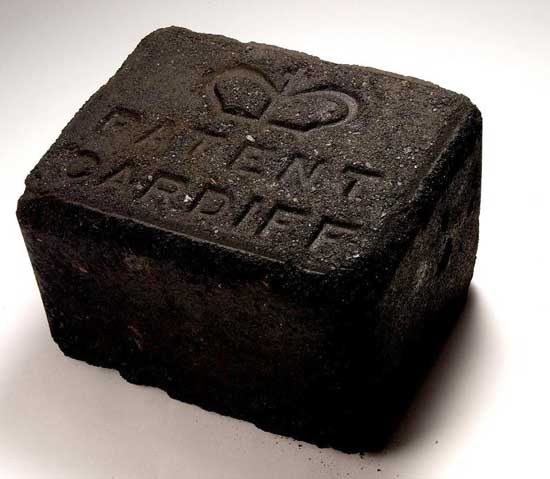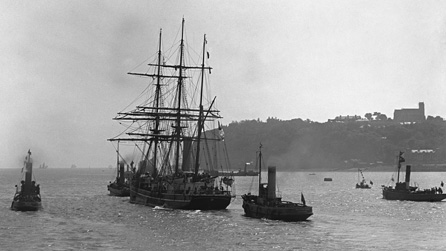Captain Scott: South for Science, National Museum Wales | reviews, news & interviews
Captain Scott: South for Science, National Museum Wales
Captain Scott: South for Science, National Museum Wales
Centenary exhibition highlights the Welsh flavour to Captain Scott's Terra Nova expedition

In a year of centenary celebrations paying homage to Captain Scott and the men who accompanied him to Antarctica at the end of the Edwardian age, two exhibitions in London have assumed pride of place. The Natural History Museum places a spotlight on the scientific achievements of the Terra Nova expedition. At the Queen’s Gallery two photographic archives capture with remarkable immediacy the sheer splendour of the polar regions.
It began when the young naval officer by the name of E.R.G.R. “Teddy” Evans sought adventure and – no doubt – advancement in the south. Assuming him to be Welsh, William Davies, the editor of the Western Mail, put his support behind Evans. When Captain Scott announced that he would be returning to Antarctica – having first travelled there on the Discovery Expedition (1901-4), succeeded by Shackleton’s almost glorious Nimrod expedition (1907-9) – Lieutenant Evans joined as his second-in-command, but carried Welsh support with him: the shipowners Daniel Radcliffe and William Tatum made significant funding contributions, as did the Chancellor of the Exchequer David Lloyd George, who stumped up £20,000.
 In honour of the Welsh contribution, Captain Scott made Cardiff the home port of the expedition, while Crown Patent Fuel, bowderlised blocks of coal, were supplied in easily stored chunks to fire the ship’s furnaces. A sample of it (pictured right) sits somewhat incongruously in a display case. The city made an impression on Scott’s men. “I don’t think we will ever forget Cardiff,” wrote Teddy Evans on 17 June 1910, the day of departure, in a letter which bears the signatures of several men whose names would go down in polar history - including Birdie Bowers and Edward Wilson. Some of Wilson’s pretty water colours of the southern continent are on display here, but his and Bowers’ names are poignantly absent from the card signed by the party of polar explorers returning to Cardiff three years later. The Terra Nova, stirring images of whose departure are also on display (pictured below), was met on the same dockside by the widowed Lady Scott three years later.
In honour of the Welsh contribution, Captain Scott made Cardiff the home port of the expedition, while Crown Patent Fuel, bowderlised blocks of coal, were supplied in easily stored chunks to fire the ship’s furnaces. A sample of it (pictured right) sits somewhat incongruously in a display case. The city made an impression on Scott’s men. “I don’t think we will ever forget Cardiff,” wrote Teddy Evans on 17 June 1910, the day of departure, in a letter which bears the signatures of several men whose names would go down in polar history - including Birdie Bowers and Edward Wilson. Some of Wilson’s pretty water colours of the southern continent are on display here, but his and Bowers’ names are poignantly absent from the card signed by the party of polar explorers returning to Cardiff three years later. The Terra Nova, stirring images of whose departure are also on display (pictured below), was met on the same dockside by the widowed Lady Scott three years later.
 Among the showpiece treasures in this small but well constructed exhibition is the prow of the Terra Nova, a virgin white figurine which ploughed through such dismal seas. But another facet of the expedition’s Welshness is explored too. One of the five men who made it to the South Pole was another Evans, this time a genuinely Welsh one: Petty Officer Edgar “Taff” Evans came from Rhossili, a small village on the promontory at the end of the Gower Peninsula, and dreamed of making his second trip south with Scott the springboard to launch himself as a publican. Scott had undimmed respect for his brute strength, but alas the only non-officer was the first to die on the way back from the South Pole, probably suffering from concussion as he lay down in the snow and made pathetic noises about catching up with the others. It's not on display here, but there is a memorial to Evans elsewhere in Wales.
Among the showpiece treasures in this small but well constructed exhibition is the prow of the Terra Nova, a virgin white figurine which ploughed through such dismal seas. But another facet of the expedition’s Welshness is explored too. One of the five men who made it to the South Pole was another Evans, this time a genuinely Welsh one: Petty Officer Edgar “Taff” Evans came from Rhossili, a small village on the promontory at the end of the Gower Peninsula, and dreamed of making his second trip south with Scott the springboard to launch himself as a publican. Scott had undimmed respect for his brute strength, but alas the only non-officer was the first to die on the way back from the South Pole, probably suffering from concussion as he lay down in the snow and made pathetic noises about catching up with the others. It's not on display here, but there is a memorial to Evans elsewhere in Wales.
 Should you find yourself in Rhossili, it’s worth visiting the church where a plaque pays tribute to the forgotten fifth man who went to the Pole 100 years ago. Rather closer to the National Museum there is another permanent memorial to Scott’s Welsh connection. It's next door in the city hall, in fact, in Cathays Park, that impressive set of municipal buildings which testify to Victorian confidence in Wales. Halfway up the stairs on the left is a commemorative tablet which was hastily commissioned soon after the Terra Nova docked. The central panel is a portrait of Scott (pictured), but around him are bas reliefs familiar from Antarctic literature: a flag flying at the Pole, the cross over the cairn under which his companion buried Scott, Wilson and Bowers. The then mayor supplies one of the names carved into the monument alongside that of the aforesaid “Dan Radcliffe JP, Hon Treasurer” and the sculptor W. Wheatley-Wagstaff.
Should you find yourself in Rhossili, it’s worth visiting the church where a plaque pays tribute to the forgotten fifth man who went to the Pole 100 years ago. Rather closer to the National Museum there is another permanent memorial to Scott’s Welsh connection. It's next door in the city hall, in fact, in Cathays Park, that impressive set of municipal buildings which testify to Victorian confidence in Wales. Halfway up the stairs on the left is a commemorative tablet which was hastily commissioned soon after the Terra Nova docked. The central panel is a portrait of Scott (pictured), but around him are bas reliefs familiar from Antarctic literature: a flag flying at the Pole, the cross over the cairn under which his companion buried Scott, Wilson and Bowers. The then mayor supplies one of the names carved into the monument alongside that of the aforesaid “Dan Radcliffe JP, Hon Treasurer” and the sculptor W. Wheatley-Wagstaff.
At the bottom, rather like a predella panel on an Renaissance altarpiece, is an image of huskies in harness gathered in front of a sledge - rather more peacefully than they ever did on the expedition itself. They are flanked on one side by a seal, on the other by a penguin, perhaps the Welshest thing of all on the southern continent. It has never been finally established, but there must have been a Welshman on the first ever trip to sail among these strange flightless birds. Penguin can also be written pen gwyn, which is Welsh for “white head”.
- Captain Scott: South for Science at National Museum Wales, Cathays Park, Cardiff until 13 May
rating
Explore topics
Share this article
The future of Arts Journalism
You can stop theartsdesk.com closing!
We urgently need financing to survive. Our fundraising drive has thus far raised £49,000 but we need to reach £100,000 or we will be forced to close. Please contribute here: https://gofund.me/c3f6033d
And if you can forward this information to anyone who might assist, we’d be grateful.

Subscribe to theartsdesk.com
Thank you for continuing to read our work on theartsdesk.com. For unlimited access to every article in its entirety, including our archive of more than 15,000 pieces, we're asking for £5 per month or £40 per year. We feel it's a very good deal, and hope you do too.
To take a subscription now simply click here.
And if you're looking for that extra gift for a friend or family member, why not treat them to a theartsdesk.com gift subscription?
more Visual arts
 'We are bowled over!' Thank you for your messages of love and support
Much-appreciated words of commendation from readers and the cultural community
'We are bowled over!' Thank you for your messages of love and support
Much-appreciated words of commendation from readers and the cultural community
 Folkestone Triennial 2025 - landscape, seascape, art lovers' escape
Locally rooted festival brings home many but not all global concerns
Folkestone Triennial 2025 - landscape, seascape, art lovers' escape
Locally rooted festival brings home many but not all global concerns
 Sir Brian Clarke (1953-2025) - a personal tribute
Remembering an artist with a gift for the transcendent
Sir Brian Clarke (1953-2025) - a personal tribute
Remembering an artist with a gift for the transcendent
 Emily Kam Kngwarray, Tate Modern review - glimpses of another world
Pictures that are an affirmation of belonging
Emily Kam Kngwarray, Tate Modern review - glimpses of another world
Pictures that are an affirmation of belonging
 Kiefer / Van Gogh, Royal Academy review - a pairing of opposites
Small scale intensity meets large scale melodrama
Kiefer / Van Gogh, Royal Academy review - a pairing of opposites
Small scale intensity meets large scale melodrama
 Jenny Saville: The Anatomy of Painting, National Portrait Gallery review - a protégé losing her way
A brilliant painter in search of a worthwhile subject
Jenny Saville: The Anatomy of Painting, National Portrait Gallery review - a protégé losing her way
A brilliant painter in search of a worthwhile subject
 Abstract Erotic, Courtauld Gallery review - sculpture that is sensuous, funny and subversive
Testing the boundaries of good taste, and winning
Abstract Erotic, Courtauld Gallery review - sculpture that is sensuous, funny and subversive
Testing the boundaries of good taste, and winning
 Edward Burra, Tate Britain review - watercolour made mainstream
Social satire with a nasty bite
Edward Burra, Tate Britain review - watercolour made mainstream
Social satire with a nasty bite
 Ithell Colquhoun, Tate Britain review - revelations of a weird and wonderful world
Emanations from the unconscious
Ithell Colquhoun, Tate Britain review - revelations of a weird and wonderful world
Emanations from the unconscious
 Rachel Jones: Gated Canyons, Dulwich Picture Gallery review - teeth with a real bite
Mouths have never looked so good
Rachel Jones: Gated Canyons, Dulwich Picture Gallery review - teeth with a real bite
Mouths have never looked so good
 Yoshitomo Nara, Hayward Gallery review - sickeningly cute kids
How to make millions out of kitsch
Yoshitomo Nara, Hayward Gallery review - sickeningly cute kids
How to make millions out of kitsch
 Hamad Butt: Apprehensions, Whitechapel Gallery review - cool, calm and potentially lethal
The YBA who didn’t have time to become a household name
Hamad Butt: Apprehensions, Whitechapel Gallery review - cool, calm and potentially lethal
The YBA who didn’t have time to become a household name

Add comment